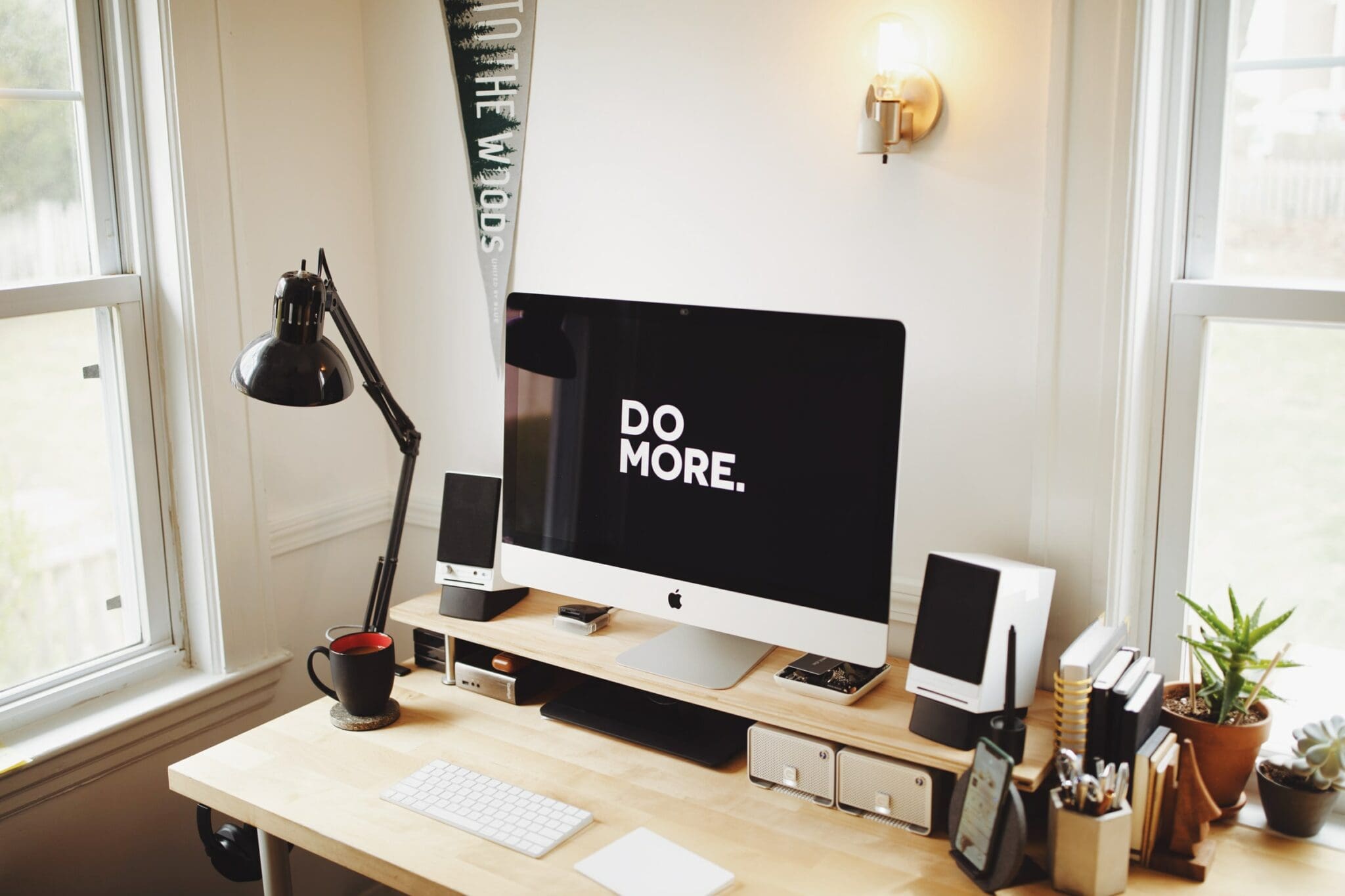When COVID-19 took hold of the world in March 2020, companies had to think fast. Remote work became mandatory to meet safety guidelines, forcing business owners and employees to wade through uncharted waters.
Luckily, innovative technologies like Zoom, Slack, Asana, Skype, and Google Hangouts made the transition more seamless. However, these apps aren’t the only factors required for a successful remote work experience. Your environment also plays a massive role in your ability to stay organized and on task.
Feature by Katie Brenneman. Photo by Carl Heyerdahl on Unsplash
Too Comfortable?
If you’re new to remote work, clocking in from your mattress can be tempting. You may already keep your laptop on your nightstand, so the natural move would be to open your eyes, roll over, prop yourself up with a pillow and get cracking on the latest project (assuming you make coffee or drink water somewhere in between).
Comfort and productivity in the same place; what’s wrong with that?
Unfortunately, being a bed breadwinner can take a toll on your physical and mental health.
Before the remote work boom, leaving the office often signified the transition from work to play. But if you’re working from bed, it can be tempting to stay somewhat horizontal all day with little to no time to unwind before doing it all over again. This may seem doable at first, but eventually, anxiety and stress will creep in.
Your bedroom should be a calm environment that promotes relaxation. Dragging deadlines, Zoom meetings, and sales calls into this sacred space will inevitably impact your sleep cycle.
Physically, working from bed can cause lower back pain, chronic fatigue, eye strain from staring at screens, and decreased hand and feet circulation. According to the World Health Organization, being sedentary for extended periods is unnatural for humans and can lead to disease and disability.
If you’re ready to give your back a break, devote a weekend to your remote work setup. Do your research and invest in an ergonomic chair and sturdy desk. Standing desks or adjustable laptop stands are great options to ensure good posture.
If you already have a chair and surface that works for you, find a space in your home with natural light and little to no noise. If that’s not possible, noise-canceling headphones and an LED lamp can do wonders. Decorations that evoke positive vibes can also make your workspace enjoyable.
Home Office Necessities
To communicate effectively with coworkers in a remote work environment, you’ll need several tools.
A strong Wi-Fi connection is non-negotiable. Whether you’re presenting a PowerPoint virtually or overseeing a project on Asana, spotty service will impede your ability to fulfill job requirements.
If you’re experiencing Wi-Fi issues, ask your internet provider about an upgrade. Depending on the options, it may make sense to shop around and switch providers. Maybe multiple people using your Wi-Fi simultaneously are causing the lag—experiment with working at a local café or invest in an Extender to boost Wi-Fi capabilities.
A printer is another excellent accessory for your home office. Heading to FedEx whenever you need to print a document can become a drain. Having your device in proximity will save you money and time.
If you have messy tendencies, a desk can turn into a paper buffet in a matter of minutes. To avoid chaos, make sure your workspace has storage. For example, invest in a filing cabinet and label your folders. Even though most documents are electronic, having a system for printed items will save you time and prevent stress.
Also, designate spots for pens, staplers, paperclips, and anything else you require daily. Having a home for every item is essential for staying organized.
Suppose you notice items piling up that you don’t need, like inkless pens, outdated documents, and half-eaten snacks; set aside time to purge your workspace at the end of the day. A minimalist setup promotes focus, productivity, and increased memory function.
Assuming you already have a laptop, investing in a second monitor can be a game-changer. For example, you can have group projects on the monitor and personal assignments on your computer with a split-screen setup. So, instead of wasting time clicking around to see who said what, all you do is move your eyes.
Still Can’t Focus?
While many people thrive in a remote work environment, some personality types feel lost without an-person accountability. However, there are ways to adapt and cultivate focus, whether you’re working with a team virtually or in person.
If you share a living space with family or friends, it’s essential to set boundaries. Designate work hours and let your housemates know you won’t be able to give them rides, help them with a tech issue, or whatever else during that time frame (except for emergencies). If they need your assistance with something, ask them to let you know several days in advance, if possible.
Depending on your company’s policies, you may be able to take a couple of hours off during the workday and make the time up in the evening or over the weekend.
Household chores can also be distracting for someone working remotely. For example, in the middle of a Skype meeting, you start thinking about switching the laundry. Then, after moving the laundry from the washer to the dryer, you notice your kids left the kitchen a mess. Before you know it, you’re scrubbing the floor, and several precious hours of daylight have vanished.
To avoid this, make time for chores before or after your workday or on weekends. Aim to maintain order in the meantime. Delegating tasks to other household members also makes a huge difference.
If you struggle with organizing your thoughts, mind mapping can help. A mind map is a visual representation of thoughts and ideas that branch out from a central main idea or topic.
Mind mapping pioneer Tony Buzan stated mind maps have the following characteristics:
- The main subject sits in the middle.
- Branches stem out from the center subject.
- Each branch holds a keyword or image printed on the designated line.
- Details radiate from each keyword or image.
- The branches form a connected structure.
Mind mapping triggers the creative side of the brain by letting you observe information in a non-linear way. By implementing connected lines, images, and colors, the mind can quickly understand associations and see categories. Typically, visuals stimulate the brain much more than a text-heavy document, making it easier to remember information for extended periods.
Finding Your Sweet Spot
It’s okay if you’re still adjusting to “the new normal.” These past two years have been a wild ride for everyone.
When it comes to remote work, experiment with different tactics until you find what’s best for your personality and career goals. Be prepared to research the latest trends and tips as more companies commit to working from home for the long haul. Most importantly, have patience with yourself and enjoy this ever-changing world!


